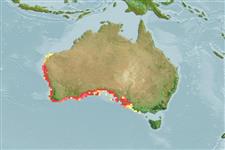>
Eupercaria/misc (Various families in series Eupercaria) >
Sillaginidae (Smelt-whitings)
Etymology: Sillago: From a locality in Australia.
Eponymy: Richard Moritz Schomburgk (1811–1891) was a gardener and botanist, who accompanied his brother Robert (see above) during his second expedition to Guiana and Venezuela. [...] (Ref. 128868), visit book page.
More on author: Peters.
Environment: milieu / climate zone / distribuzione batimetrica / distribution range
Ecologia
marino; salmastro demersale; non migratori; distribuzione batimetrica 0 - 30 m (Ref. 6205), usually 0 - 2 m (Ref. 27657). Temperate; 21°S - 39°S, 111°E - 142°E (Ref. 6205)
Eastern Indian Ocean: endemic to Australia, from Dampier to Albany in Western Australia and Gulf St Vincent and Spencer Gulf waters in South Australia. It is not known whether they also occur in the intervening waters.
Length at first maturity / Size / Peso / Age
Maturità: Lm 22.5 range ? - ? cm
Max length : 42.0 cm TL maschio/sesso non determinato; (Ref. 27296); Età massima riportata: 12 anni (Ref. 27008)
Spine dorsali (totale) : 11 - 13; Raggi dorsali molli (totale) : 19 - 22; Spine anali: 2; Raggi anali molli: 17 - 20; Vertebre: 37. Its swim bladder is without a median anterior extension.
Body shape (shape guide): elongated; Cross section: circular.
Generally frequent inshore sand banks, bars, and spits, and congregate in sandy hollows. At high tide they move in schools across the sand flats and retreat to the slopes of the banks when the tide falls. These whiting are principally marine residents (Ref. 27646, 27012), and can tolerate upper Spencer Gulf waters with salinity as high as 40-50 ppt (Ref. 6390). They may also penetrate to the limit of the brackish water in tidal creeks, where salinity is as low as 1 ppt (Ref. 6335, 27012). Juveniles inhabit warmer water, mangrove-lined creeks and inshore protected environments (Ref. 27012) over mud bottoms and seagrass beds (Ref. 6390). The spawning season commences in September and is completed by January in Shark Bay and slightly later along the coast to the south (Ref. 6390). Oviparous (Ref. 205), and are multiple spawners with asynchronous development (Ref. 27656).
Multiple spawners with asynchronous development (Ref. 27656).
McKay, R.J., 1992. FAO Species Catalogue. Vol. 14. Sillaginid fishes of the world (family Sillaginidae). An annotated and illustrated catalogue of the sillago, smelt or Indo-Pacific whiting species known to date. Rome: FAO. FAO Fish. Synop. 125(14):87p. (Ref. 6205)
IUCN Red List Status (Ref. 130435: Version 2025-1)
Threat to humans
Harmless
Human uses
Pesca: scarso interesse commerciale; Acquacoltura: probabile utilizzo futuro; Pesce da pesca sportiva: si
Strumenti
Special reports
Download XML
Fonti Internet
Estimates based on models
Preferred temperature (Fonte Biblio.
123201): 16 - 23.8, mean 18 °C (based on 175 cells).
Phylogenetic diversity index (Fonte Biblio.
82804): PD
50 = 0.5000 [Uniqueness, from 0.5 = low to 2.0 = high].
Bayesian length-weight: a=0.00575 (0.00271 - 0.01223), b=3.06 (2.88 - 3.24), in cm total length, based on LWR estimates for this Genus-body shape (Ref.
93245).
Trophic level (Fonte Biblio.
69278): 3.2 ±0.2 se; based on diet studies.
Resilienza (Fonte Biblio.
120179): Medio, tempo minimo di raddoppiamento della popolazione 1.4 - 4.4 anni (K=0.49-0.53; tm=2; tmax=12; Fec=170,000).
Fishing Vulnerability (Ref.
59153): Low to moderate vulnerability (27 of 100).
🛈
Nutrients (Ref.
124155): Calcium = 168 [35, 411] mg/100g; Iron = 0.425 [0.144, 1.179] mg/100g; Protein = 20.6 [17.7, 22.9] %; Omega3 = 0.357 [0.153, 0.845] g/100g; Selenium = 9.84 [2.92, 43.23] μg/100g; VitaminA = 18.4 [3.1, 98.6] μg/100g; Zinc = 0.669 [0.349, 1.644] mg/100g (wet weight);
